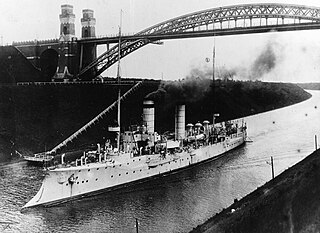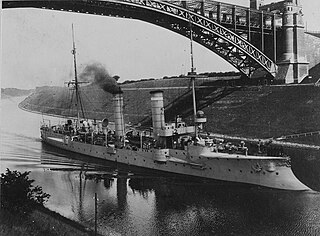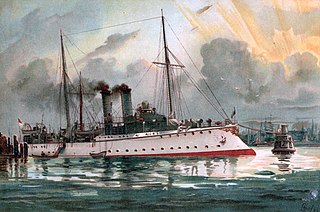
SMS Seeadler was an unprotected cruiser of the Bussard class, the third member of a class of six ships built by the German Kaiserliche Marine. Her sister ships included Bussard, the lead ship, along with Falke, Condor, Cormoran, and Geier. Seeadler was built at the Kaiserliche Werft in Danzig in late 1890, launched in February 1892, and commissioned in August of that year. Intended for colonial service, Seeadler was armed with a main battery of eight 10.5-centimeter (4.1 in) guns and had a top speed of 15.5 knots.

SMS Arcona was the ninth member of the ten-ship Gazelle class of light cruisers that were built for the German Kaiserliche Marine in the late 1890s and early 1900s. The Gazelle class was the culmination of earlier unprotected cruiser and aviso designs, combining the best aspects of both types in what became the progenitor of all future light cruisers of the Imperial fleet. Built to be able to serve with the main German fleet and as a colonial cruiser, she was armed with a battery of ten 10.5 cm (4.1 in) guns and a top speed of 21.5 knots. Arcona was a modified version of the basic Gazelle design, with improved armor and additional coal storage for a longer cruising range.

SMS Fürst Bismarck was Germany's first armored cruiser, built for the Kaiserliche Marine before the turn of the 20th century. The ship was named for the German statesman Otto von Bismarck. The design for Fürst Bismarck was an improvement over the previous Victoria Louise-class protected cruisers—Fürst Bismarck was significantly larger and better armed than her predecessors.

SMS Gefion was an unprotected cruiser of the German Kaiserliche Marine, the last ship of the type built in Germany. She was laid down in March 1892, launched in March 1893, and completed in June 1895 after lengthy trials and repairs. The cruiser was named after the earlier sail frigate Gefion, which had been named for the goddess Gefjon of Norse mythology. Intended for service in the German colonial empire and as a fleet scout, Gefion was armed with a main battery of ten 10.5-centimeter (4.1 in) guns, had a top speed in excess of 19.5 knots, and could steam for 3,500 nautical miles, the longest range of any German warship at the time. Nevertheless, the conflicting requirements necessary for a fleet scout and an overseas cruiser produced an unsuccessful design, and Gefion was rapidly replaced in both roles by the newer Gazelle class of light cruisers.

SMS Medusa was a member of the ten-ship Gazelle class of light cruisers that were built for the German Kaiserliche Marine in the late 1890s and early 1900s. The Gazelle class was the culmination of earlier unprotected cruiser and aviso designs, combining the best aspects of both types in what became the progenitor of all future light cruisers of the Imperial fleet. Built to be able to serve with the main German fleet and as a colonial cruiser, she was armed with a battery of ten 10.5 cm (4.1 in) guns and a top speed of 21.5 knots. Medusa served in all three German navies—the Kaiserliche Marine, the Reichsmarine of Weimar Germany, and the Kriegsmarine of Nazi Germany—over the span of over forty years.

SMS Amazone was the sixth member of the ten-ship Gazelle class of light cruisers that were built for the German Kaiserliche Marine in the late 1890s and early 1900s. The Gazelle class was the culmination of earlier unprotected cruiser and aviso designs, combining the best aspects of both types in what became the progenitor of all future light cruisers of the Imperial fleet. Built to be able to serve with the main German fleet and as a colonial cruiser, she was armed with a battery of ten 10.5 cm (4.1 in) guns and a top speed of 21.5 knots.

SMS Thetis was the fourth member of the ten-ship Gazelle class of light cruisers that were built for the German Kaiserliche Marine in the late 1890s and early 1900s. The Gazelle class was the culmination of earlier unprotected cruiser and aviso designs, combining the best aspects of both types in what became the progenitor of all future light cruisers of the Imperial fleet. Built to be able to serve with the main German fleet and as a colonial cruiser, she was armed with a battery of ten 10.5 cm (4.1 in) guns and a top speed of 21.5 knots.

SMS Geier was an unprotected cruiser of the Bussard class built for the German Imperial Navy. She was laid down in 1893 at the Imperial Dockyard in Wilhelmshaven, launched in October 1894, and commissioned into the fleet a year later in October 1895. Designed for service in Germany's overseas colonies, the ship required the comparatively heavy armament of eight 10.5 cm (4.1 in) SK L/35 guns and a long cruising radius. She had a top speed of 15.5 kn.

SMS Bussard was an unprotected cruiser of the Imperial German Navy, built in the 1880s. She was the lead ship of her class, which included five other vessels. The cruiser's keel was laid in 1888, and she was launched in January 1890 and commissioned in October of that year. Intended for overseas duty, Bussard was armed with a main battery of eight 10.5-centimeter (4.1 in) guns, and could steam at a speed of 15.5 knots.

SMS Falke was an unprotected cruiser of the Bussard class, built for the Imperial German Navy. She was the second member of the class of six vessels. The cruiser was laid down in 1890, launched in April 1891, and commissioned into the fleet in September of that month. Designed for overseas service, she carried a main battery of eight 10.5-centimeter (4.1 in) guns and had a top speed of 15.5 knots.

SMS Condor was an unprotected cruiser of the Imperial German Navy. She was the fourth member of the Bussard class, which included five other vessels. The cruiser's keel was laid down in Hamburg in 1891, she was launched in February 1892, and was commissioned in December of that year. Intended for overseas duty, Condor was armed with a main battery of eight 10.5-centimeter (4.1 in) guns, and could steam at a speed of 15.5 knots.

SMS Cormoran was an unprotected cruiser of the Bussard class, the fifth member of a class of six ships. She was built for the Imperial German Navy for overseas duty. The cruiser's keel was laid down in Danzig in 1890; she was launched in May 1892 and commissioned in July 1893. Cormoran was armed with a main battery of eight 10.5-centimeter (4.1 in) guns, and could steam at a speed of 15.5 knots.

SMS Schwalbe was an unprotected cruiser built for the German Kaiserliche Marine, the lead ship of the Schwalbe class. She had one sister ship, Sperber. Schwalbe was built at the Kaiserliche Werft in Wilhelmshaven; her keel was laid down in April 1886 and her completed hull was launched in August 1887. She was commissioned for service in May 1888. Designed for colonial service, Schwalbe was armed with a main battery of eight 10.5-centimeter (4.1 in) guns and had a cruising radius of over 3,000 nautical miles ; she also had an auxiliary sailing rig to supplement her steam engines.

SMS Sperber was an unprotected cruiser built for the German Kaiserliche Marine, the second member of the Schwalbe class. She had one sister ship, Schwalbe. Sperber was built at the Kaiserliche Werft in Danzig; her keel was laid down in September 1887 and her completed hull was launched in August 1888. She was commissioned for service in April 1889. Designed for colonial service, Sperber was armed with a main battery of eight 10.5-centimeter (4.1 in) guns and had a cruising radius of over 3,000 nautical miles ; she also had an auxiliary sailing rig to supplement her steam engines.

The Schwalbe class of unprotected cruisers were the first ships of the type built for the German Kaiserliche Marine. The class comprised two ships, Schwalbe, the lead ship, and Sperber. They were designed for service in Germany's recently acquired colonial empire, and were built between 1886 and 1889. They were armed with a main battery of eight 10.5-centimeter (4.1 in) guns and could steam at a speed of 13.5 knots.

The Bussard class of unprotected cruisers were built for the German Kaiserliche Marine in the late 1880s and early 1890s. The class comprised six ships: Bussard, the lead ship, Falke, Seeadler, Cormoran, Condor, and Geier. Designed for service in Germany's colonial empire, the class emphasized a long-range cruising radius and relatively heavy armament; they were also the last cruisers in the Kaiserliche Marine to be equipped with an auxiliary sailing rig. The ships were equipped with eight 10.5-centimeter (4.1 in) guns.

SMS Iltis was the lead ship of the Iltis class of gunboats built for the German Kaiserliche Marine in the late 1890s and early 1900s. Other ships of the class are SMS Luchs, SMS Tiger, SMS Eber, SMS Jaguar, and SMS Panther.

SMS Luchs was the fourth member of the Iltis class of gunboats built for the German Kaiserliche Marine in the late 1890s and early 1900s. Other ships of the class are SMS Iltis, SMS Tiger, SMS Eber, SMS Jaguar and SMS Panther.



















